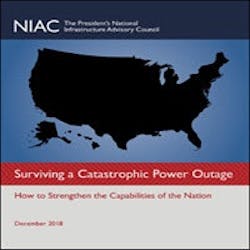The nation has steadily improved its ability to respond to major disasters and the power outages that often result. But increasing threats—whether severe natural disasters, cyber-physical attacks, electromagnetic events, or some combination—present new challenges for protecting the national power grid and recovering quickly from a catastrophic power outage.
The President’s National Infrastructure Advisory Council (NIAC) was tasked to examine the nation’s ability to respond to and recover from a catastrophic power outage of a magnitude beyond modern experience, exceeding prior events in severity, scale, duration, and consequence. Simply put, how can the nation best prepare for and recover from a catastrophic power outage, regardless of the cause?
After interviews with dozens of senior leaders and experts and an extensive review of studies and statutes, we found that existing national plans, response resources, and coordination strategies would be outmatched by a catastrophic power outage. This profound risk requires a new national focus. Significant public and private action is needed to prepare for and recover from a catastrophic outage that could leave the large parts of the nation without power for weeks or months, and cause service failures in other sectors—including water and wastewater, communications, transportation, healthcare, and financial services—that are critical to public health and safety and our national and economic security.
